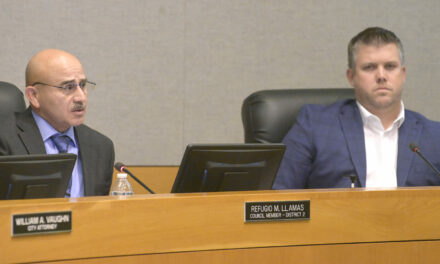Plans to add 130,000 acre feet of water storage to the San Luis Reservoir are moving forward.
The Department of the Interior and the San Luis & Delta-Mendota Water Authority on Friday announced plans to go ahead and start the project that will raise the earthen face by 10 feet of the B.F. Sisk Dam visible as you take Highway 152 over the Pacheco Pass.
It will create enough storage to supply more than 2 million people, a million acres of farmland, and 135,000 acres of Pacific Flyway Wetlands.
It is one of three key reservoir projects on the west side of the Central Valley in various stages of inching forward that ultimately will add 1,827,000 acre feet of off-stream storage space.
That compares to the 2.1 million acre foot existing capacity of San Luis Reservoir.
“San Luis Reservoir has served as the hub of California’s water system south of the Sacramento San Joaquin Bay-Delta since its completion in 1967,” said San Luis & Delta-Mendota Water Authority Board Chair Cannon Michael. “The ability to capture more water in the years it is available, particularly given California’s changing climate, is a critical component of a more secure future for the communities, farms and wildlife dependent on the Central Valley Project for their water supply. “
The expansion project will piggyback on a seismic re-enforcement project already underway for B.F. Sisk Dam.
San Luis is the national’s largest off-stream reservoir.
As such almost all of the water that flows into it is diverted from the natural stream or river beds.
In the case of San Luis, it stores federal Central Valley Project water captured behind Shasta and Whiskeytown Dam that is released into the Sacramento River and diverted into the Delta-Mendota Canal from the Delta near Mountain House northeast of Tracy.
The water flows to San Luis Reservoir in the second of two large canals you cross heading west on Interstate 580 over the Altamont Pass near the Alameda County line. The first canal is the California Aqueduct.
Off-stream reservoirs dovetail into changing climate scenarios.
And they do so without interrupting fish flows and such.
Long before “climate change” became prevalent in modern day conversations, the concept of large dams in the Sierra and higher elevation of the foothills for water storage per se as opposed to flood control had passed.
San Luis Reservoir, completed in 1967 in the Diablo Range foothills west of Los Banos, is the largest off-stream reservoir in the United States with 2 million acre feet of storage. Even in non-drought years, the water level can get low.
That’s because it is fed by excess stormwater as well as excess snowmelt from the Sierra.
It’s a holding pond, if you will, for water ultimately heading farther south.
“Through President Biden’s Investing in America agenda, Reclamation has reached a major milestone today for the B.F. Sisk Dam Raise and Reservoir Expansion Project, which will build water supply security for farmers and families in the region,” said Principal Deputy Assistant Secretary for Water and Science Michael Brain.
“As California and the West deal with historic drought conditions, the Biden-Harris administration is working in close coordination with local communities, states and Tribes to build climate resilience and long-term water supply reliability for future generations.”
The four off-stream
water storage projects
The B.F. Sisk Dam endeavor is one of three reservoir projects in the Diablo Range on the westside of both the Northern San Joaquin Valley and the Delta are part of a strategy to store receive runoff during wet years to cushion California water supplies against prolonged drought.
The projects — raising the San Luis Reservoir dam, building a Del Puerto Canyon dam and raising Los Vaqueros Reservoir — would add 245,000 acre feet of water storage capacity.
When coupled with the proposed Sites Reservoir in the Antelope Valley portion of the Coastal Range — of which the Diablo Range is a subrange — an additional 1,827,000 acre feet of off-stream storage could be created.
The Sites Reservoir — first proposed in the 1950s — is on target to become the state’s next major reservoir.
Nestled in foothills of western Colusa and Glenn counties, it has been inching in earnest toward groundbreaking and a 2031 target completion date for the better part of the last decade since voters approved a statewide water bond in 2014.
It is designed to add up to 1.3 million acre feet of storage that would be used to help supply water for up to 27 million Californians and 500,000 acres of Central Valley farmland. It also would provide water for fish needs in dry years.
The Del Puerto Canyon reservoir project west of Patterson on Interstate 5 south of Tracy in Stanislaus County would add 82,000 acre feet.
The Los Vaqueros project in Contra Costa County would add 115,000 acre feet of capacity to bring it to 275,000 acre feet of overall storage. It is to the northwest of Tracy.
Together, the four projects would create almost a third of the capacity now in the State Water Project that can store 5.8 million acre feet with the most being behind Oroville Dam with 3.5 million acre feet.
The four projects are equal to almost a sixth of the storage capacity of the 12 million acre foot Central Valley Water Project. Shasta Dam with 4.5 million acre feet is its biggest component.
As such, the four projects combined represent a significant increase in California’s surface storage.


